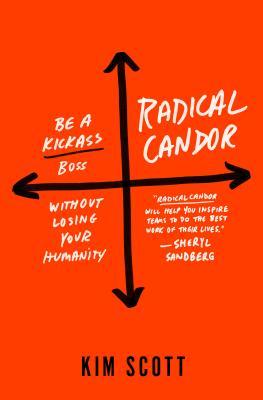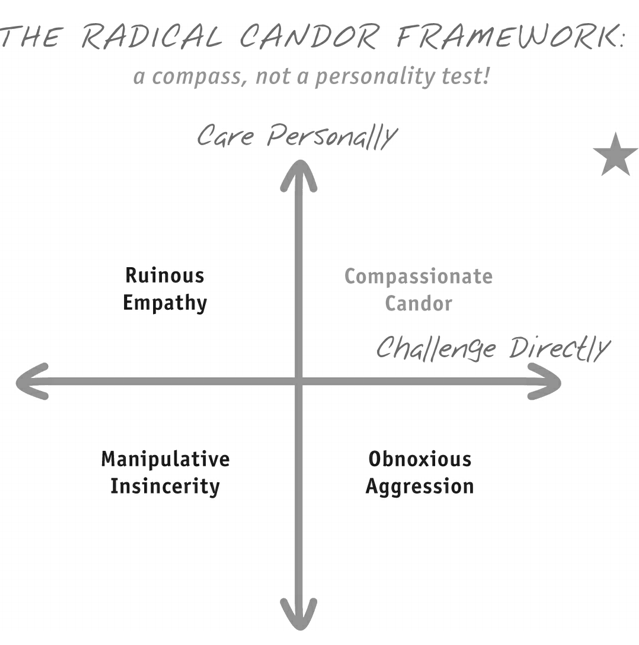 Kim Scott’s Radical Candor is a way of managing people which is built upon two key tenets: caring personally (about our team members, far beyond their work output) and challenging directly (by not avoiding tough conversations). When enacted correctly, it leads to more trusting relationships, more effective collaboration and better team growth.
Kim Scott’s Radical Candor is a way of managing people which is built upon two key tenets: caring personally (about our team members, far beyond their work output) and challenging directly (by not avoiding tough conversations). When enacted correctly, it leads to more trusting relationships, more effective collaboration and better team growth.
However, when misunderstood, it can also perpetuate myths around aggressive leadership stances, so let’s get to the crux of the techniques that it offers.
“Don’t Be An Asshole” takes priority
The latest edition of Radical Candor comes with an important preface, reflecting misunderstandings and misuses of the author’s intentions in the mainstream media (such as in the episode of Silicon Valley which is seen in the GIF at the top of the page). Specifically, the “radical” variant of candor is often portrayed the same as aggressiveness, rudeness or toxicity, when it actually has compassion at its heart.
Scott clarifies that the ideas in the book are not intended to be an excuse for “bad boss behaviour”:
To me the word “radical” indicates a management philosophy that is both new and dramatically different from what came before. The idea that bosses should use their power to behave like bullies is old and banal, not new and radical. The key insight behind Radical Candor is that command and control can hinder innovation and harm a team’s ability to improve the efficiency of routine work.
The Radical Candor Framework, explained
Given the above revelations, the latest edition of Radical Candor seeks to clarify misunderstandings by portraying our desired behaviour as “compassionate candor”, in the new version of the framework pictured below:

The diagram also highlights the quadrants that you fall into when you fail to both care personally, and challenge directly:
- If you challenge without caring, this is obnoxious aggression. Often this takes the form of broad, non-specific compliments, whereas criticisms are often deeply (and overly) personal.
- If you care about people, but you don’t challenge them when needed, this is ruinous empathy. We prevent people from becoming the best versions of themselves by holding-back on advice which could help someone to learn or grow.
- If you neither care nor challenge, this ineffectiveness of leadership is termed manipulative insincerity - you don’t want any hassle - including anybody thinking badly of you - so you often roll-over weakly and allow an “anything goes” approach within your team.
Each of these alternative quadrants highlights why a Compassionate Candor approach is not just a good idea - it’s basically the only approach that will work.
Growing through trust
By practising sincerity and specificity when giving both praise and blame to teams, it gives them full agency to shape their situation, in the knowledge that you’re not attempting to manipulate them, nor are you attempting to coerce them to act in a way that puts your needs first. It’s an approach which benefits being introduced slowly, carefully, over time: you can’t “force” trust to grow artificially, they have to be constructed through repeated demonstrations of living your values. This includes having an understanding and an appreciation of self-care techniques, and a knowledge of where each other’s boundaries lie.
One of the best ways of fostering this trust is by not just giving radical candor, but also asking for it back from your team. Make it clear that you’re open to criticism - publically, if it makes their feedback easier to give - and display gratitude when you receive suggestions for improvement, as you appreciate the effort to make changes happen.
However, when offering radical candor as a leader, one of the most important concepts is “public praise, private criticism”. It’s great to celebrate successes within your team and wider organisation, as it encourages reciprocal behaviours; however a public humiliation (however slight) can have the reverse impact, and result in your team shutting-down their input for fear of being next in the spotlight.
And remember, not everybody is the same. A major part of the Radical Candor journey is understanding the different “growth trajectories” that your team members might be on, and how your candor for their particular path can help to manage (or accelerate) progress in ways which it hasn’t been occurring before.
Better collaboration through openness
The final goal of Radical Candor that I’d like to highlight (though there are many more we’ve not touched upon) is harnessing it to improve your team’s collaborative processes, through a seven-step process:
- Listening: Understanding when you should keep silent, allowing your team to fill the void with their ideas; and when it’s best to take a more active role to stimulate a stale conversational tract. But don’t just do this yourself - teach your team how to listen to each other, especially to those who might not always have the loudest voice in a room.
- Clarifying: Participating in brainstorming sessions (both group and one-on-one) to ensure that ideas are refined until they are clearly understood and agreed upon, rather than starting a project or task with only a vague idea of the desired outcome.
- Debating: Chairing an “open floor” during debates, and keeping the sessions focused on the debate itself, rather than committing to an on-the-spot decision on an outcome. Successful facilitation also means making sure that debate is respectful, and results in the team coming up with the best decision, rather than just focusing on “winning”.
- Deciding: Ensuring that decision-makers are brought together at the right time, to make informed and prompt judgements around work activities.
- Persuading: Making sure that decisions are communicated to everybody, positively and empathetically, with an opportunity for Q&A regarding the approach that was agreed upon.
- Executing: Or, more specifically, ensuring your team is executing effectively, by removing obstacles and visualising workstreams to avoid blockers or ambiguities.
- Learning: Analysing results/metrics and welcoming feedback on how a process was conducted, to ensure the opportunity to improve in any future processes.
By following these steps, and demonstrating a belief and caring nature for your team, they’ll be encouraged to bring their best selves to work, and together achieve winning results.
Key takeaways 📝
- Nobody’s asking you to “fake” caring. Just care.
- Being honest doesn’t mean being a jerk.
- Communication is a two-way street. Invite candor from your team, too.
